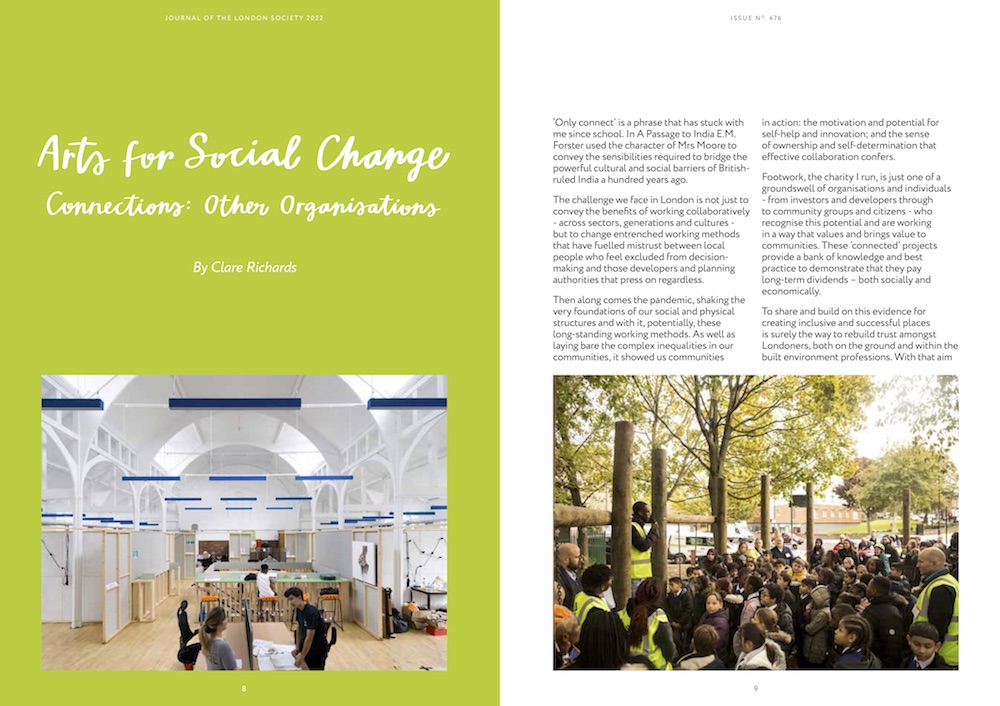Post
Journal 2022 | Arts for Social Change
5 Aug 2022
Journal 476 was published last month with its theme of Connections. (You can buy a copy here - 100 pages of top quality writing and photography, book reviews, reportage and London history.)
In this latest piece from its pages, Clare Richards of Footwork looks at how communities are working together to build, change and engage.
‘Only connect’ is a phrase that has stuck with me since school. In A Passage to India E.M. Forster used the character of Mrs Moore to convey the sensibilities required to bridge the powerful cultural and social barriers of British- ruled India a hundred years ago.
The challenge we face in London is not just to convey the benefits of working collaboratively - across sectors, generations and cultures - but to change entrenched working methods that have fuelled mistrust between local people who feel excluded from decision- making and those developers and planning authorities that press on regardless.
Then along comes the pandemic, shaking the very foundations of our social and physical structures and with it, potentially, these long-standing working methods. As well as laying bare the complex inequalities in our communities, it showed us communities in action: the motivation and potential for self-help and innovation; and the sense of ownership and self-determination that effective collaboration confers.
Footwork, the charity I run, is just one of a groundswell of organisations and individuals - from investors and developers through to community groups and citizens - who recognise this potential and are working in a way that values and brings value to communities. These ’connected’ projects provide a bank of knowledge and best practice to demonstrate that they pay long-term dividends – both socially and economically.
To share and build on this evidence for creating inclusive and successful places is surely the way to rebuild trust amongst Londoners, both on the ground and within the built environment professions. With that aim Footwork launched Collaborative Change, an online catalogue of the spontaneous and innovative projects prompted by the pandemic – including some very unlikely cross-sector alliances. Another longer running project, the New London Awards’ Community Prize, celebrates projects that are “community-driven, created collaboratively and make a positive impact on local identity”.
One such project is Marklake Court, a development of 27 affordable, council-rent homes created on the site of underused garages on the Kipling Estate, near London Bridge. This was conceived by residents who formed a Community Benefit Society, in partnership with Southwark Council, to address local housing needs. Hari Phillips, Director of Bell Phillips Architects, explains their role in the process: “We began literally with a blank sheet of paper and started with an open conversation about the community’s hopes, fears and concerns. The development team engaged in a dialogue early, with our role being the facilitators and curators.” A local resident at Marklake Court adds: “Involving residents right from the very start has enabled us to get the very best outcome for this site, delivering as many homes as possible to meet the acute housing need.”
The Granville, winner of the 2019 Community Prize, is a mixed-use community building housed in a 19th century church hall owned by Brent Council. South Kilburn Trust,
who conceived and now run it, acted on an identified need for employment and to facilitate local enterprise. “We also targeted the community to ask what they wanted, so we were responsive; it doesn’t happen organically,” says CEO Carl Blackburn. Anthony Staples at RCKa, architects for the project explains: “Different stakeholder groups have the money, space, needs and expertise – so this cross-sector angle to collaboration is key. The best projects bring everyone together as equal project partners. The result is a building that meets many different community requirements, and really plays its role in making social interactions happen.”
Shortlisted for the Community Prize, Build Up Hackney is a popular public space, created by young people on an unloved thoroughfare in Flanders Way, now featuring a circular seating area with swings, new lighting and artwork. Thanks to their extensive local research, the project drew on a unique combination of skills, strengths and connections. “Everyone from the local Over 60s Club through to the local youth engagement organisation became key features and backers of the project,” Huan Rimington, Director of Build Up, which gets young people designing and building in their local community. “The difference that organisations working together makes is that people can genuinely have a permanent stake in their communities’ built environment.” According to a young Build Up participant “It’s not a one-man job. And it’s not even a two, three man job. It’s a collaborative teamwork effort. And without that communication, it just wouldn’t work.”
My investigations revealed other important features of these projects: they value local knowledge and experience; they take a long- term view and are adaptable as needs evolve; and they have the active support of local councils. I asked what lasting lessons can be learnt. For Hari Phillips the key lesson is that “this bottom-up approach gives people a sense of ownership and pride, ultimately leading to better quality homes that will be welcomed, cared-for and that will stand the test of time. Communities, provided with the right resources and support, can and should be trusted to deliver their own housing, like Marklake Court.” Anthony Staples says: “there was a lot of personal learning for us as architects with regards to the importance of honesty, patience and humility when bringing people together behind a single vision; and about building trust and understanding between multiple local-interest groups and personalities.”
As The Granville prepares for a second phase, of 18 new council flats, Carl Blackburn sums it up very simply: “By reaching such a wide variety of people the community knows the building belongs to everybody.”
You can get your copy of Journal 476 here.
